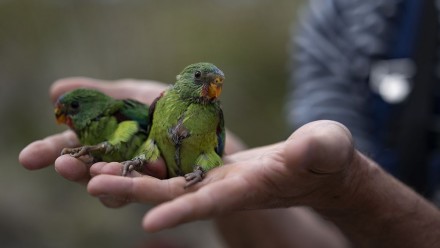Dr Natasha Robinson

Contacts
Natasha is a conservation ecologist, with a background in fire ecology and management. She is passionate about Australia’s unique flora and fauna and is particularly concerned about improving the conservation of threatened species. Her research interests include reintroduction biology, threatened species monitoring and management, and fire ecology and management.
Natasha has led several research projects as Research Fellow for the National Environmental Science Program Threatened Species Recovery Hub (NESP TSR hub). These include leading research and monitoring for two threatened species (southern brown bandicoot, eastern quoll) to Booderee National Park; and reviewing fauna responses to fire-associated management actions.
This work has involved many partners including Parks Australia, Booderee National Park, Wreck Bay Aboriginal Community Council, WWF Australia, NSW Forestry Corporation and Quoll Conservation sanctuaries (Devils @ Cradle Wildlife Park, Trowunna Wildlife Sanctuary, and Aussie Ark). She has contributed to research on improving threatened species monitoring and management and developing indicators to measure impact of conservation research.
Before moving to Canberra, Natasha was based in Victoria where she had spent ten years working and studying in diverse ecosystems including tall wet forests, the Mallee, foothill forest and box ironbark forests. After several years working in land management, Natasha returned to academia to complete a PhD in fire ecology and avian conservation at La Trobe University.
Her study was located in the Central Highlands following the 2009 Black Saturday Bushfire. This large, severe wildfire was used to investigate the role of unburnt patches as refuges for birds, examining the importance of fire, vegetation, topographic and landscape properties to avian persistence post-fire.
This research was integrated into her subsequent role as Senior Biodiversity Officer for the Victorian State Government. In this role, she led the development of a five year Monitoring, Evaluation and Reporting plan for the East Central Bushfire Risk Landscape, advising on ecosystem and species management in relation to fire and assisting with planned burning and bushfire response.
Research interests
- Fire Ecology and Management
- Threatened Species Monitoring
- Adaptive Management
- Conservation Biology
- Reintroduction Biology
- Shrestha, S, Thapa, A, Bista, D, et al. Distribution and habitat attributes associated with the Himalayan red panda in the westernmost distribution range. Ecol Evol. 2021; 11: 4023– 4034.
- Lavery, T. H., Morgain, R., Fitzsimons, J. A., Fluin, J., Macgregor, N. A., Robinson, N. M., Scheele, B. C., Selwood, K. E., Spindler, R., Vuong, H., West, S., Wintle, B. A., & Lindenmayer, D. B. (2021). Impact indicators for biodiversity conservation research: Measuring influence within and beyond academia. BioScience, 71 (4) (2021), pp. 383-395
- Robinson, N.M., Rhoades, C., Pierson, J. et al. Prioritising source populations for supplementing genetic diversity of reintroduced southern brown bandicoots Isoodon obesulus obesulus. Conserv Genet 22, 341–353 (2021).
- Robinson, N, Dexter, N, Brewster, R et al. 2020, 'Be nimble with threat mitigation: lessons learned from the reintroduction of an endangered species', Restoration Ecology, vol. 28, no. 1, pp. 29-38.
- Robinson, N, Blanchard, W, MacGregor, C et al. 2020, 'Can evolutionary theories of dispersal and senescence predict postrelease survival, dispersal, and body condition of a reintroduced threatened mammal?', Ecology and Evolution, vol. 11, no. 2, pp. 1002-1012pp.
- Robinson, N, Blanchard, W, MacGregor, C et al. 2020, 'Finding food in a novel environment: The diet of a reintroduced endangered meso-predator to mainland Australia, with notes on foraging behaviour', PLOS ONE (Public Library of Science), vol. 15, no. 12.
- Lindenmayer, D, Blanchard, W, Blair, D et al. 2021, 'The response of arboreal marsupials to long-term changes in forest disturbance', Animal Conservation, vol. 24, no. 2, pp. 246-258.
- Scheele, B, Legge, S, Blanchard, W et al. 2019, 'Continental-scale assessment reveals inadequate monitoring for threatened vertebrates in a megadiverse country', Biological Conservation, vol. 235, pp. 273-278.
- Lindenmayer, D, Wood, J, MacGregor, C et al 2018, 'Conservation conundrums and the challenges of managing unexplained declines of multiple species', Biological Conservation, vol. 221, pp. 279-292pp.
- Lindenmayer, D, Lane, P, Westgate, M et al. 2018, 'Tests of predictions associated with temporal changes in Australian bird populations', Biological Conservation, vol. 222, pp. 212-221.
- Robinson, N, MacGregor, C, Hradsky, B et al 2018, 'Bandicoots return to Booderee: Initial survival, dispersal, home range and habitat preferences of reintroduced southern brown bandicoots (eastern sub species; Isoodon obesulus obesulus)', Wildlife Research, vol. 45, no. 2, pp. 132-142.
- Scheele, B, Legge, S, Armstrong, D et al 2018, 'How to improve threatened species management: An Australian perspective', Journal of Environmental Management, vol. 223, pp. 668-675.
- Robinson, N, Scheele, B, Legge, S et al. 2018, 'How to ensure threatened species monitoring leads to threatened species conservation', Ecological Management and Restoration, vol. 19, no. 3, pp. 222-229pp.
- Kelly, L, Haslem, A, Holland, G et al 2017, 'Fire regimes and environmental gradients shape vertebrate and plant distributions in temperate eucalypt forests', Ecosphere, vol. 8, no. 4, pp. e01781-e01781.
- Foster, C, Barton, P, Robinson, N et al. 2017, 'Effects of a large wildfire on vegetation structure in a variable fire mosaic', Ecological Applications, vol. 27, no. 8, pp. 2369-2381pp.
- Robinson, N, Leonard, S, Bennett, A et al 2016, 'Are forest gullies refuges for birds when burnt? The value of topographical heterogeneity to avian diversity in a fire-prone landscape', Biological Conservation, vol. 200, pp. 1-7.
- Robinson, N, Leonard, S, Bennett, A et al 2014, 'Refuges for birds in fire-prone landscapes: The influence of fire severity and fire history on the distribution of forest birds', Forest Ecology and Management, vol. 318, pp. 110-121.
- Robinson, N, Leonard, S, Ritchie, E et al. 2013, 'Refuges for fauna in fire-prone landscapes: their ecological function and importance', Journal of Applied Ecology, vol. 50, no. 6, pp. 1321-1329.










